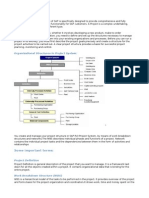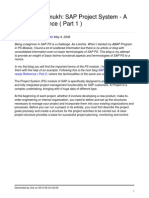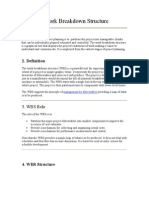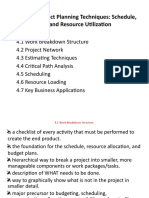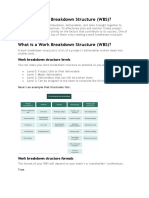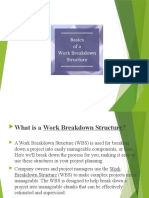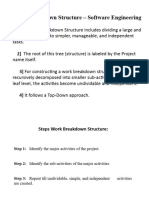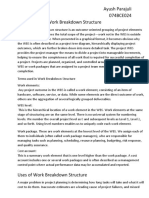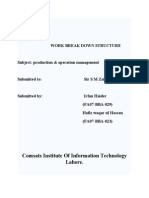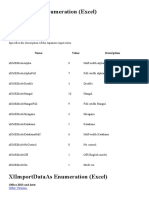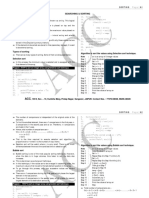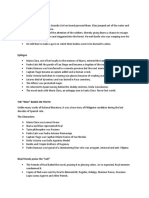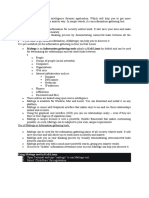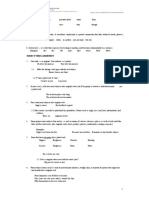Chapter 5
Operative Structures
To manage a project successfully throughout its life, you must have clearly
defined objectives and structured work. A well thought-out project plan is
the cornerstone of successful project organization, planning and control.
In the Project System, you can define the operative structures that you use to
carry out your project, such as:
�project definition
�work breakdown structure
�network
�milestones
Project Definition
You use the project definition to describe project goals in general terms. The
project definition is like a mission statement. At this point, you do not need
to create a work breakdown structure or activities. In later planning phases,
the project definition is the framework for all objects to be created in the
system, for example, elements in a work breakdown structure or activities in
a network.
Work Breakdown Structure (WBS)
The work breakdown structure (WBS) is the hierarchical model of the tasks
to be performed in the project. It provides an overview of the project.
�WBS is the basis for organization and coordination in the project.
�WBS contains the work, time and costs involved in the project.
The WBS is also the basis for subsequent planning once the project is under-
way. You can use the work breakdown structure to create schedules as well
as plan fixed dates, costs and budget.
In addition to copying from a standard WBS to create a new work break-
down structure, you can also include portions of existing work breakdown
structures. You can select a sub-tree from another project (WBS) and insert it
into the new project (WBS) you are creating, thereby ensuring that the same
tasks are carried out and saving some data entry work.
5-1
�5 Operative Structures
WBS Elements In the Project System, the individual tasks necessary to carry out the project
are represented by the individual elements in the work breakdown structure,
called WBS elements (work breakdown structure elements). You can break
these elements down further into more detail, depending on the phase of
your project.
Figure 5-1: The Work Breakdown Structure (WBS)
Operative Indicator for You can determine the properties that a WBS element will have in the project
Project Execution by using one or more of the following operative indicators:
�planning
WBS elements, for which you want to plan your actual costs.
�account assignment
WBS elements, to which you want to post costs
�billing
WBS elements, to which you want to post revenues.
You can assign specific organizational units, such as plant and business area,
to WBS elements. When you do not make special assignments, the system
uses the organizational data from the project definition.
Organizational Data You can assign a piece of equipment or a functional location to WBS ele-
ments for plant maintenance projects.
5-2
� Operative Structures 5
In the WBS elements you define the areas of responsibility and responsible Accountability
people for the project - for example, project manager, requesting or respon-
sible cost center, and controlling area.
The user-defined fields in the WBS elements are available so that you can User-defined Fields
enter additional information that is relevant to your company.
Networks
Through the activities in a network, you can plan the people, capacities,
materials, production resources/tools, and services needed for your project.
Activities and their relationships make up the most important part of a net-
work.
Figure 5-2: The Network
Depending on the tasks to be performed in the project, you can create Activities
different types of activities.
�An internally processed activity is used for those tasks that you carry
out within your company where capacity (such as machine or
personnel) is a factor.
�An externally processed activity is used for all tasks to be performed
outside your company or by outsiders. This activity creates the link to
the purchasing system where you can refer to a purchasing info record
and get prices and delivery times. The system automatically creates a
purchase requisition from the data in the externally processed activity.
5-3
�5 Operative Structures
�A general costs activity is used for planning costs without referencing
other objects in the system. You can also capture incurred costs that are
not directly related to any one activity, for example, travel expenses.
Activity elements are useful when you need to break down the activities
further into more detailed elements. Each activity can have internal, external,
or general cost elements.
You can plan materials needed to carry out the project through the material
components allocated in the network.
Miscellaneous production resources/tools, that you require during the pro-
ject, for example, drawings, tools, or equipment can be allocated to the
activities.
User-Defined Fields By using user-defined fields in network activities, you can enter additional
information relevant to your company.
Relationships Dependencies between activities because of time or technical reasons are
represented by relationships. The relationships determine how the individ-
ual activities are linked to each other in the network:
�Finish-Start relationship
Relationship in which the preceding activity must finish before the
following activity may start
�Start-Start relationship
Relationship in which one activity cannot start until the other has
started
�Finish-Finish relationship
Relationship in which one activity cannot finish until the other has
finished
�Start-Finish relationship
Relationship in which one activity cannot finish until the other has
started
Linking Networks Together Not only can you link activities within a network using relationships, you
can also link activities in different networks. You can use this function to
group activities together into a smaller, easy-to-manage network or into an
overall network to develop a schedule across all networks.
Linking Activities to Work Network activities provide another level of detail in the work breakdown
Breakdown Structure structure. You can assign them to WBS elements. Using the WBS, you can
roll-up cost, schedule, and capacity data from the network activities for
analyses.
5-4
� Operative Structures 5
You can use subnetworks to refine and detail your networks as planning Subnetworks
progresses. You simply break down a network activity into one or more
subnetworks. The system treats subnetworks and networks the same, that is,
you can plan dates, capacities, costs, materials and production resource/
tools in a subnetwork as well.
You can maintain your work breakdown structures and networks graphi- Graphics
cally. The hierarchy graphic gives you an overview of your project and the
network structure graphic gives you an overview of all networks linked
together with relationships.
You can create the following print files for network and hierarchy graphics:
�GRANEDA Metafile for printing on a plotter
�Postscript file for printing on a laser printer
�HPGL format file
Milestones
Milestones are events which occur during the life of the project which are of
either particular significance, or trigger pre-defined functions. They are gen-
erally used to mark points of transition from one phase to the next in a pro-
ject or from one department to another. You can assign milestones to net-
work activities or WBS elements.
In the Project System, milestones are used:
�to trigger predefined milestone functions in network activities
�in the milestone technique in earned value analysis
�to determine dates in the billing plan for a sales order
You can use the predefined milestone functions in networks to trigger a Milestone Functions in
sequence of steps for a specific business process, such as: Networks
�releasing activities
�including standard networks
�creating subnetworks
�creating networks
�starting workflow tasks
5-5
�5 Operative Structures
Milestone Dates in For customer projects, such as in engineer-to-order manufacturing, you usu-
Billing Plans ally bill the customer once certain phases have been completed in his project.
When you have milestones representing phases in networks or WBS ele-
ments, you can use these milestones to create a billing plan. Once a milestone
is reached, the Project System automatically copies the actual date from the
milestone into the billing plan so you can bill the customer.
What are the advantages of PS operative structures?
You can:
❏ expand and update data and structures continuously (from rough-cut
planning to detailed planning).
❏ create work breakdown structures and networks quickly and easily in
the PS graphics.
❏ use milestones to trigger a workflow, to copy dates into a billing plan or
simply to mark a significant project phase.
5-6

